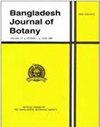Development and Test of Rice Nitrogen Nutrition Index Estimation Model Based on Airborne Multi-Spectrum
IF 0.3
4区 生物学
Q4 PLANT SCIENCES
引用次数: 0
Abstract
Both excessive and deficient nitrogen (N) concentration in the growing media can affect the growth, development, yield, and quality of rice. Traditional methods of N determination of plant require destructive and rigorous sampling, which is also time-consuming and laborious. However, rapid and non-destructive nitrogen diagnosis has become an important area of research in precision agriculture. Heilongjiang Province, China is a cold climate rice growing area, where the growth and fertilization of rice follows a definite pattern. In the present study, two varieties of rice (Wuyoudao4 and Songjing9) and as location Heilongjiang Province were selected. Nitrogen diagnosis of rice was carried out based on airborne multi-spectrum methodology. Canopy spectral data of rice at key growth periods were obtained by using a UAV equipped with a multi-spectral camera, and agronomic parameters such as leaf N content and dry matter weight were obtained synchronically. An airborne multispectral canopy normalized vegetation index (NDVI) model for N diagnosis based on its critical concentration curve was established as a nondestructive N diagnosis of rice for cold region. Results showed that canopy NDVI can estimate rice nitrogen nutrition index (NNI) properly over the growth period. The coefficient of determination R2, root mean square error (RMSE) and standard root mean square error (nRMSE) were compared to determine the best effect of the index model. The interphase nitrogen diagnosis model of WYD-4 based on NDVI for cold region was as follows: NNI=0.3916e1.0809*NDVI (RMSE=0.12, nRMSE=12.43%), SJ-9: NNI=0.3325e1.2705*NDVI (RMSE=0.10, nRMSE =10.36%), indicating that the established model can better estimate the nitrogen status of rice. Bangladesh J. Bot. 52(2): 529-538, 2023 (June) Special基于机载多谱的水稻氮营养指数估算模型的建立与试验
生长介质中氮浓度过高或过低都会影响水稻的生长发育、产量和品质。传统的植物氮测定方法需要破坏性采样和严格采样,耗时费力。然而,快速、无损的氮素诊断已成为精准农业的一个重要研究领域。中国黑龙江省属寒气候水稻种植区,水稻的生长和施肥有一定的规律。本研究选择了两个水稻品种(武有道4号和松京9号)和作为产地的黑龙江省。采用机载多光谱法对水稻氮素进行了诊断。利用配备多光谱相机的无人机获取水稻关键生育期冠层光谱数据,同步获取叶片氮含量、干物质重等农艺参数。建立了基于临界浓度曲线的航空多光谱冠层归一化植被指数(NDVI)模型,作为寒区水稻氮素的无损诊断方法。结果表明,冠层NDVI能较好地估算水稻生育期氮素营养指数(NNI)。比较决定系数R2、均方根误差(RMSE)和标准均方根误差(nRMSE),确定指标模型的最佳效果。寒区基于NDVI的WYD-4间期氮素诊断模型为:NNI=0.3916e1.0809*NDVI (RMSE=0.12, nRMSE=12.43%), SJ-9: NNI=0.3325e1.2705*NDVI (RMSE=0.10, nRMSE= 10.36%),表明所建立的模型能较好地估计水稻氮素状况。[j] .植物学报,52(2):529- 538,2023(6):特刊
本文章由计算机程序翻译,如有差异,请以英文原文为准。
求助全文
约1分钟内获得全文
求助全文
来源期刊

Bangladesh Journal of Botany
生物-植物科学
CiteScore
0.80
自引率
0.00%
发文量
77
审稿时长
9 months
期刊介绍:
Bangladesh in situated on the north of Bay of Bengal. Climatically it is a humid subtropical country. Most of the land is deltaic plain of two great rivers, the Ganges and the Bhrammaputra and it tributaries. The country has rich diversity of plants. Main crops cultivated are Rice, Jute, Wheat, Maize, Sugarcane, Mustard and different kinds of Lentils. There are a good number of Public and Private Universities and Plant Research Establishments.
Bangladesh Journal of Botany is the official organ of the Bangladesh Botanical Society established in 1972. Since 1972 Bangladesh Journal of Botany is being published regularly. Two issues of the Journal are published, one in June and another in December.
Scientific papers (Full paper and short communication) on any field of Plant Sciences from anywhere in the World are considered for publication in Bangladesh Journal of Botany.
 求助内容:
求助内容: 应助结果提醒方式:
应助结果提醒方式:


